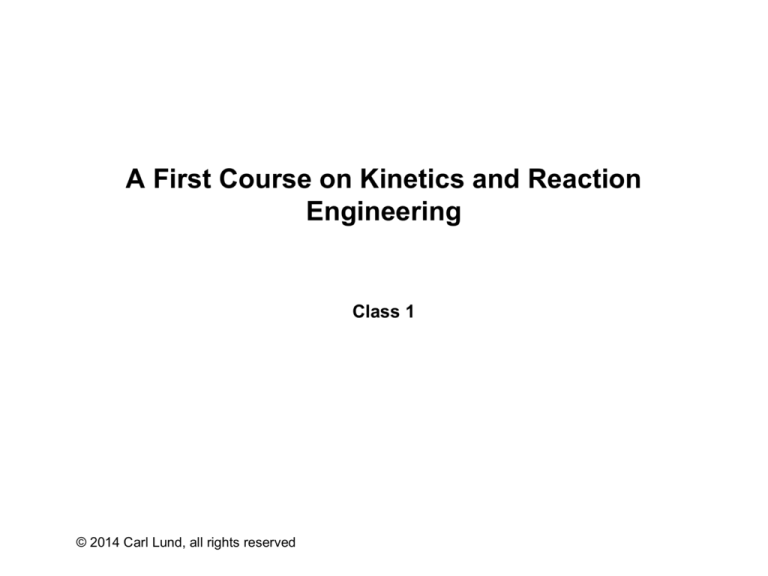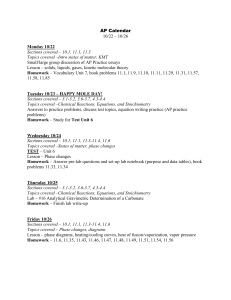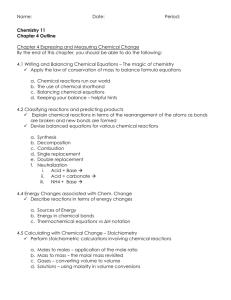
A First Course on Kinetics and Reaction
Engineering
Class 1
© 2014 Carl Lund, all rights reserved
Where We’ve Been
• Part I - Chemical Reactions
‣ 1. Stoichiometry and Reaction Progress
‣ 2. Reaction Thermochemistry
‣ 3. Reaction Equilibrium
• Part II - Chemical Reaction Kinetics
• Part III - Chemical Reaction Engineering
• Part IV - Non-Ideal Reactions and Reactors
Unit 1 Summary/Review
• Fields that Involve Chemical Reactions
‣ Kinetics – field of science concerned with understanding and modeling the rates of chemical
reactions
- The resulting model is called the rate equation or rate expression
‣ Reaction Engineering – branch of chemical engineering concerned with understanding and
modeling chemical reactors
- Reaction engineering models are called design equations and are comprised of mole
balances, an energy balance and a momentum balance
- Rate expressions (kinetics models) appear within the design equations (reaction
engineering models)
‣ Reaction Thermodynamics includes equilibrium analysis and energy changes associated with
reactions
• Chemical Reactions
‣ Involve bond breaking and forming among reactants and products
- No atoms gained or lost so reaction must be “balanced”
‣ Written similar to mathematical equations except arrows instead of equals sign
-
Use the symbol νi,j to denote the stoichiometric coefficient of species i in reaction j
•
•
If i is a reactant, νi,j < 0
If i is a product, νi,j > 0
‣ Some biological phenomena, including cell growth and enzyme-catalyzed reactions, can be
treated in a manner analogous to chemical reactions
- Nomenclature can be different
- Cell growth doesn’t have a fixed stoichiometry; use an effective stoichiometry
Characterizing How Far a Reaction has Gone
(Reaction Progress)
• Extensive and Intensive Variables
• Reaction Progress Variables
‣ Single reaction: extent, conversion, etc.
xj
n -n )
(
=
ni0 - ni
fi =
ni0
0
i
i
n i, j
‣ Multiple reactions: extent, yield, selectivity, etc.
N ind
ni = ni0 + ån i, jx j
j=1
-
Complete mathematically independent sub-set of the reactions that are taking place
‣ Reversible reactions: fraction of equilibrium conversion
• Limiting Reagent: the one that will run out first
• Mole Tables
Species
Initial Moles
Final Moles
i
ni0
n + å n i, jx j
⋮
⋮
⋮
Total
ån
N ind
0
i
j=1
0
i
all i
æ 0 Nind
ö
å çè ni + ån i, jx j ÷ø
all i
j=1
Questions?
Reaction Progress Learning Activity
• Consider the reaction 4 NH
+ 5 O2 → 4 NO + 6 H2O taking place in a
closed, constant volume reactor (V = 1 L). At the start of the process, the
reactor held one mole of NH3 and 0.15 mole of O2.
3
• To solve some problems in this course, you will need to write an
expression for the concentration of O2 in terms of the concentration of NH3
and the initial composition of the system.
• To solve other problems (in Part I of the course) you will need to write
expressions for the mole fractions of each of the four species (NH3, O2,
NO and H2O) in terms of the extent of the reaction and the initial
composition of the system.
• To solve still other problems in this course, you will need to calculate the
concentration of O2, given the fractional conversion of NH3 and the initial
composition of the system.
Identifying Stoichiometry Problems
• To succeed, you need to be able to
‣ Read a problem statement and analyze it to determine what type of problem it is
‣ Know how to approach each particular problem (without reference to solved examples, etc.)
• Chemical reactions will be central to almost every type of problem in this
course
‣ As we progress through the course new problem types will be encountered
‣ Each time this happens, the associated learning activities will provide some guidance on how
to identify the new problem type and how to approach the solution of the problem
• Stoichiometry problems are introduced in Unit 1
‣ Key features of typical reaction stoichiometry problems
-
The reactions taking place are known
-
The problem entails finding values or expressions for other, unknown quantities related to
the final composition or the progress of reactions
The initial composition of the system is known
One or more quantities related to the final composition or the progress of the reactions
taking place are known
‣ Solving stoichiometry problems is sometimes a step within larger problems
-
Calculation of equilibrium compositions (Unit 3 of AFCoKaRE)
Analysis of kinetics data (Section C of Part II of AFCoKaRE)
General Approach to Stoichiometry Problems
• Identify a complete, mathematically independent sub-set of the reactions
•
•
that are taking place (see Supplemental Unit S1)
Construct a mole table (optional)
Write the defining equations for each of the quantities given in the problem
statement in terms of the extent(s) of the independent reactions
‣ Most are defined in terms of moles, so write definition in terms of moles and then substitute
expressions for final moles in terms of extents
• Solve for the extents of the independent reactions (as values or as
•
expressions in terms of the given quantities)
Write the defining equations for each quantity you are asked to find in
terms of the extent(s) of the independent reactions
‣ Again, most are defined in terms of moles, so write definition in terms of moles and then
substitute expressions for final moles in terms of extents
‣ Substitute the extents found above to obtain the requested quantities
• See the How-To files provided with Unit 1
Practice Applying the General Approach
to Stoichiometry Problems
• Your group has been assigned one of the three problems for this activity
• Work through the general approach given on the previous slide, applying it
to your problem
‣ Do NOT refer to any solved examples from the readings or other sources
‣ Don’t bother to solve any of the equations that result
‣ Just set the problem up
• If you get stuck, feel free to talk to other groups or to call me over to help
you
• In a few minutes you will combine with other groups and explain your
solution procedure to them
Where We’re Going
• Part I - Chemical Reactions
‣ 1. Stoichiometry and Reaction Progress
‣ 2. Reaction Thermochemistry
‣ 3. Reaction Equilibrium
• Part II - Chemical Reaction Kinetics
• Part III - Chemical Reaction Engineering
• Part IV - Non-Ideal Reactions and Reactors





